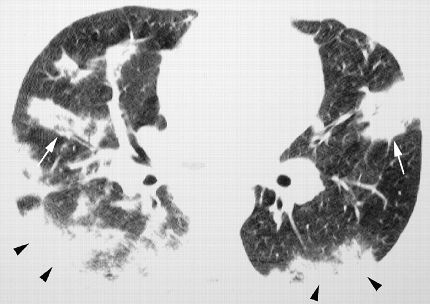This article describes the signs and symptoms of pneumonia, treatment and complications that can occur in children with pneumonia >>. << What is pneumonia? Pneumonia is an infection of the lungs and respiratory system. This leads to inflammation and normal lung air sacs (alveoli) are filled with fluid. Pneumonia can vary in severity from mild illness to one that is potentially life-threatening. Traditionally, it was called `old men friends because she often brought death in the elderly and infirm. Bacterial infections - which can develop after upper respiratory track, as cold, sore throat or flu. The bacterium causes 50% of pneumonia, most often streptococci bacteria known as Chlamydia pneumoniae
- more common in children of school age. This is a different bacteria than the one that leads to venereal disease
pnevmotsistnoy which occurs in people with suppressed immune infections such as those undergoing chemotherapy, had organ transplants, AIDS patients and those treated with corticosteroids
Other causes of pneumonia include fungi, parasites, chemical or physical damage strattera to the lungs, tuberculosis, lung cancer, alcohol abuse. SARS (severe acute respiratory syndrome) is especially dangerous infectious and type of pneumonia, first held in China in 2002. Aspiration pneumonia occurs when stomach contents are inhaled into the lungs after vomiting (which is why people pass out drunk to watch carefully so they do not vomit during sleep). The incubation period in different ways depending on what causes pneumonia, but symptoms can begin anywhere from 18 hours to six days after exposure to bacteria or virus. Hippocrates, the father of modern medicine who lived between 460 BC and 380 BC, and then called pneumonia, was named the ancient. Just as the signs and symptoms listed, you know that some children only symptom of pneumonia may be rapid breathing, or just high fever, abdominal pain or vomiting. Some young children may be, they simply sleepy or have a poor appetite. Pneumonia in children also sometimes mistaken as appendicitis. Symptom of a child not getting enough oxygen in their body will be blue / gray / white color around the lips. Nails also show how much oxygen the body perfusion blue or gray nails indicate a lack of oxygen (which is why patients requested anesthesia to remove nail polish, so the anesthesiologist can set the level of oxygen in the body) >> << The doctor will review, listen to the chest stethoscope may order tests of blood, mucus cough test and chest X-ray
Depending on the cause of pneumonia, the doctor will prescribe appropriate treatment. For example, bacterial infection, he / she will prescribe antibiotics
Hospitalization may be required if your child is very sick with high fever, has difficulty breathing or is unable to keep food and liquid down Children
long-term health problems 'pits, are at greater risk, such as those of the heart or lungs, diabetes or asthma
Those who work with chemicals and solvents or live / work in a contaminated environment. Death - left untreated, pneumonia can ultimately lead to death (pneumonia is the leading cause of death of children worldwide)
What can I do for my child with pneumonia? Give your child plenty of fluids and easily digestible, nutritious diet
Vaccines such as pertussis vaccine and Hemophilus influenza may protect against pneumonia. For more information visit our Kiwi Families section, which includes informed consent and the pros and cons of vaccination. After a few excellent tips on how to manage your sick child, go to our article in this section. Kimberly Patterson is a writer and public relations expert living in Whangaparoa. It is an early career nurses and spent 20 years writing about health and well-being. Article written Pneumonia Kimberley Paterson. .




